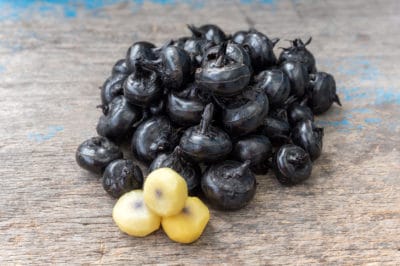If They’re Not Nuts, What Are They?
Chinese water chestnuts (Eleocharis dulcis) come from perennial aquatic plants of the Sedge (Cyperaceae) family. Although they look like grass, they’re grown not for their stems but for their edible underground corms. The coconut-apple flavored vegetables are much easier to peel than the chestnuts they’re named after.
How Chinese Water Chestnuts Grow
During spring and summer, water chestnuts put all their energy into growing the tubular, stemlike leaves they need for photosynthesis. Once the days begin to shorten in midsummer, they begin storing some of their photosynthesized sugar in modified underground stems, or corms.
As the corms multiply, they get larger and sweeter and the plants’ above-ground parts turn yellow and die. Over a seven-month growing season, each corm can multiply dozens of times. The goal is to harvest all of them at the peak of sweetness, but before they begin to sprout new stems.
Expert gardener’s tip: Do you wonder why water chestnut corms stay so crunchy even when cooked or canned? The answer lies in the phenolic substances, including ferulic acid, that strengthen their cell walls. As an antioxidant, ferulic acid may help lower blood pressure and blood sugar levels.
Where Chinese Water Chestnuts Grow
Chinese water chestnuts are native to the wetlands of tropical Asia, where the wild plants flourish in the summer heat and saturated, mucky soil. Smaller wild populations also occur in:
- India
- Polynesia
- Australia
- New Guinea
Most cultivated Chinese water chestnuts come from mainland China, Hong Kong or Taiwan. In the United States, they can be cultivated in USDA zones 8 through 11. They need a frost-free growing season of at least seven months. Because of the labor involved in harvesting the corms, large-scale U.S. cultivation has yet to succeed.
Beware the “Other” Water Chestnut
Another aquatic plant sometimes cultivated for its nutlike fruit is the European water chestnut (Trapa natans), or water caltrop. In the course of a growing season, one plant can become 100 — and its nuts’ spines can penetrate shoes. In the U.S., water caltrop is on the invasive or noxious weed list in 13 states and the District of Columbia.
